CO Detection System Based on TDLAS Using a 4.625 μm Interband Cascaded Laser
Abstract
:1. Introduction
2. TDLAS Detection Principle
3. Experimental Equipment
4. Results and Discussion
5. Conclusions
Author Contributions
Funding
Institutional Review Board Statement
Informed Consent Statement
Data Availability Statement
Acknowledgments
Conflicts of Interest
References
- Gu, L.S.; Pei, Y.J.; Wang, L.N.; Guo, H.L. TDLAS carbon monoxide concentration detection system. Ship Sci. Tech. 2019, 41, 134–137. [Google Scholar]
- Ma, L. Application of TDLAS Technology in the Field of Coal Mine Gas Disaster Detection. S. Coal Mines 2015, 46, 87–89. [Google Scholar]
- Liang, Y.T.; Tian, F.C.; Feng, W.B.; Shao, Z.L.; Meng, X.N.; Chen, C.F. Research progress of coal mine gas detection technology in China. J. CHN. Coal Soc. 2021, 46, 1701–1714. [Google Scholar]
- Zheng, W.X.; Zheng, C.T.; Yao, D.; Yang, S.; Dang, P.P.; Wang, Y.D. Development of a Mid-Infrared Interband Cascade Laser Methane Sensor. Acta Opt. Sinica 2018, 38, 0328013. [Google Scholar] [CrossRef]
- Lv, M.; Wang, Y.D.; Chen, C. Development of Mid-Infrared Trace-CO Detector with Long-Path Differential Optical Absorption Spectroscopy (LP-DOAS). Spectrosc. Spect. Ana. 2017, 37, 2278–2282. [Google Scholar]
- Roy, A.; Chakraborty, A.L. Quantum cascade laser-based in situ measurement of atmospheric CO and CO2 in Gandhinagar using 1f and 2f wavelength modulation spectroscopy. In Proceedings of the Workshop on Recent Advances in Photonics, Guwahati, India, 13–14 December 2019. [Google Scholar]
- Zhang, H.L.; Wu, T.; He, X.D. Progress of Measurement of Infrared Absorption Spectroscopy Based on QCL. Spectrosc. Spect. Ana. 2019, 9, 2751–2757. [Google Scholar]
- Chen, X.; Yang, C.G.; Hu, M.; Shen, J.K.; Niu, E.C.; Xu, Z.Y.; Fan, X.L.; Wei, M.; Yao, L.; He, Y.B.; et al. Highly-sensitive NO, NO2, and NH3 measurements with an open-multipass cell based on mid-infrared wavelength modulation spectroscopy. Chin. Phy. B. 2018, 4, 040701. [Google Scholar] [CrossRef]
- Xie, Y.; Chang, J.; Chen, X.; Sun, J.; Zhang, Q.; Wang, F.; Zhang, Z.; Feng, Y. A DFB-LD Internal Temperature Fluctuation Analysis in a TDLAS System for Gas Detection. IEEE Photonics J. 2019, 3, 6801708. [Google Scholar] [CrossRef]
- Feng, Y.; Chang, J.; Chen, X.; Zhang, Q.; Wang, Z.; Sun, J.; Zhang, Z. Application of TDM and FDM methods in TDLAS basedmulti-gas detection. Opt. Quant. Electron. 2021, 53, 195. [Google Scholar] [CrossRef]
- Wang, C.; Jiang, M.; Huang, Q.; Zhou, W.; Jiang, Y.; Tian, S. Detection and calibration method for decomposition of sulfur hexafluoride based on TDLAS. In Proceedings of the Applied Optics and Photonics China, Beijing, China, 30 November–2 December 2020. [Google Scholar]
- Wang, Y.; Wei, Y.; Liu, T.; Sun, T.; Kenneth, T.V. TDLAS Detection of Propane/Butane Gas Mixture by Using Reference Gas Absorption Cells and Partial Least Square Approach. IEEE Sens. J. 2018, 18, 8587–8596. [Google Scholar] [CrossRef]
- Chen, H.; Ju, Y.; Han, L. Research on the Relationship Between Modulation Depth and Center of High Order Harmonic in TDLAS Wavelength Modulation Method. Spectrosc. Spect. Ana. 2021, 41, 3676–3681. [Google Scholar]
- Werle, P.; Slemr, F.; Maurer, K.; Kormann, R.; Muecke, R.; Jaenker, B. Near- and mid-infrared laser-optical sensors for gas analysis. Opt. Lasers Eng. 2002, 37, 101–114. [Google Scholar] [CrossRef]
- Kluczynski, P.; Axner, O. Theoretical description based on Fourier analysis of wavelength-modulation spectrometry in terms of analytical and background signals. Appl. Opt. 1999, 38, 5803–5815. [Google Scholar] [CrossRef]
- Chen, C.; Wang, B.; Li, C.G.; Li, J.; Wang, Y.D. A Trace Gas Sensor Using Mid-Infrared Quantum Cascaded Laser at 4.8μm to Detect Carbon Monoxide. Spectrosc. Spect. Ana. 2014, 34, 838–842. [Google Scholar]
- Dang, J.; Kong, L.; Zheng, C.; Wang, Y.; Sun, Y.; Yu, H. An open-path sensor for simultaneous atmospheric pressure detection of CO and CH4 around 2.33μm. Opt. Lasers Eng. 2019, 123, 1–7. [Google Scholar] [CrossRef]
- Shao, L.; Fang, B.; Zheng, F.; Qiu, X.; He, Q.; Wei, J.; Li, C.; Zhao, W. Simultaneous detection of atmospheric CO and CH4 based on TDLAS using a single 2.3μm DFB laser. Spectrochim. Acta A 2019, 222, 117118. [Google Scholar] [CrossRef] [PubMed]
- Tang, F.; Liu, S.G.; Lv, Q.S.; Li, X.T.; He, S.K.; Zeng, X.Z.; Yue, Y.Q. Experimental study on the detection of trace H2S and H2O in high-voltage combination appliances based on TDLAS technology. In Proceedings of the Advanced Sensor Systems and Applications IX, Hangzhou, China, 20 November 2019. [Google Scholar]
- Werle, P. A review of recent advances in semiconductor laser based gas monitors. Spectrochim. Acta A 1998, 54, 197–236. [Google Scholar] [CrossRef]
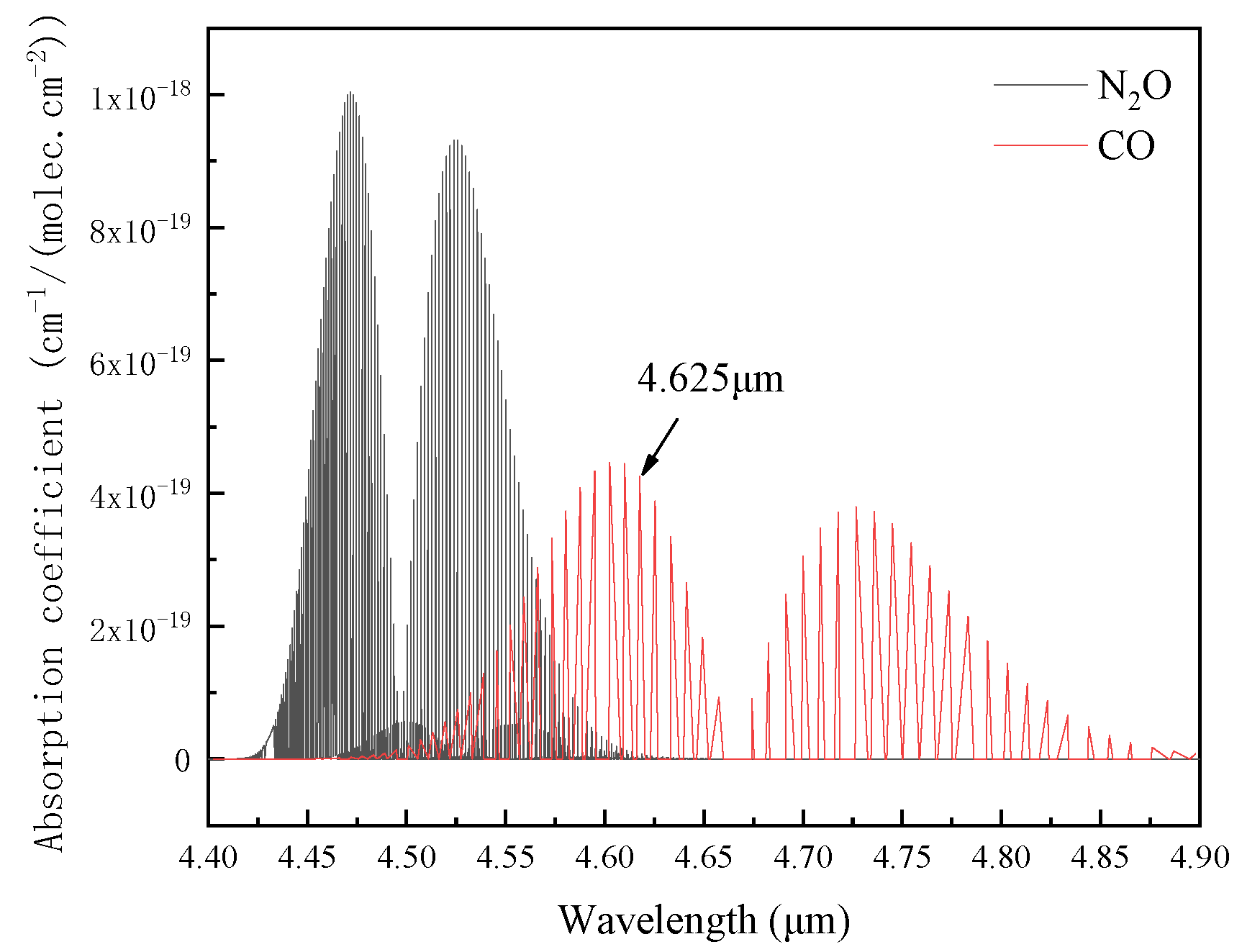
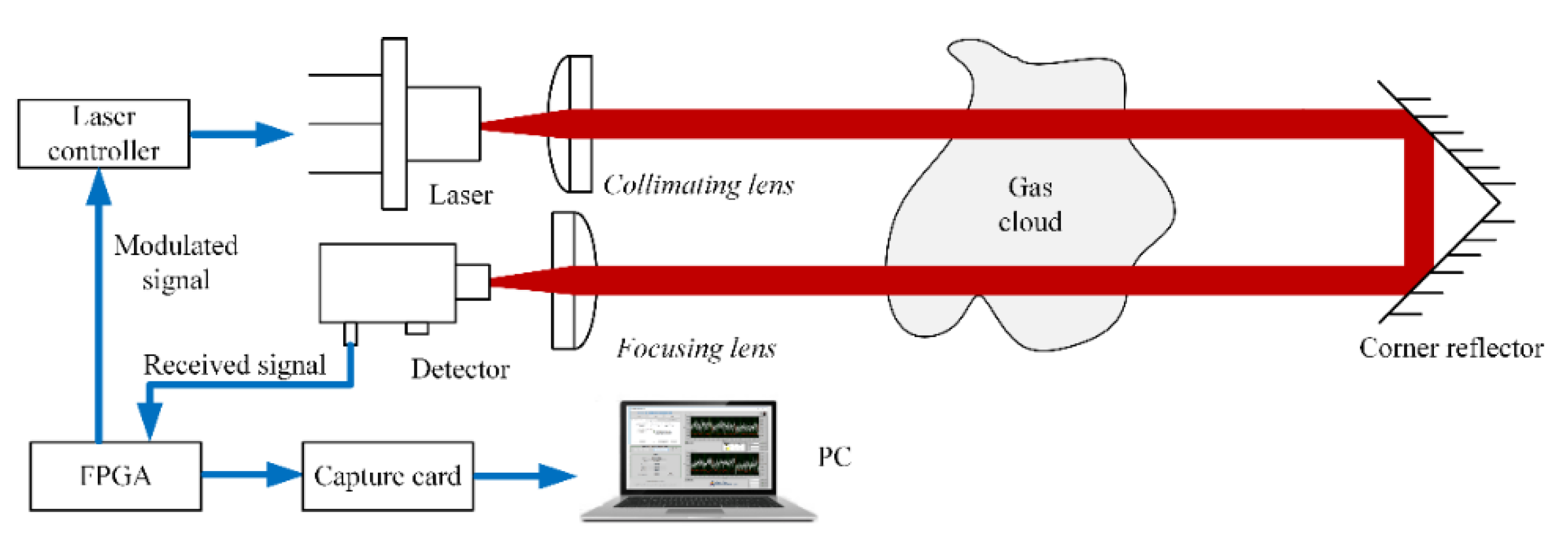
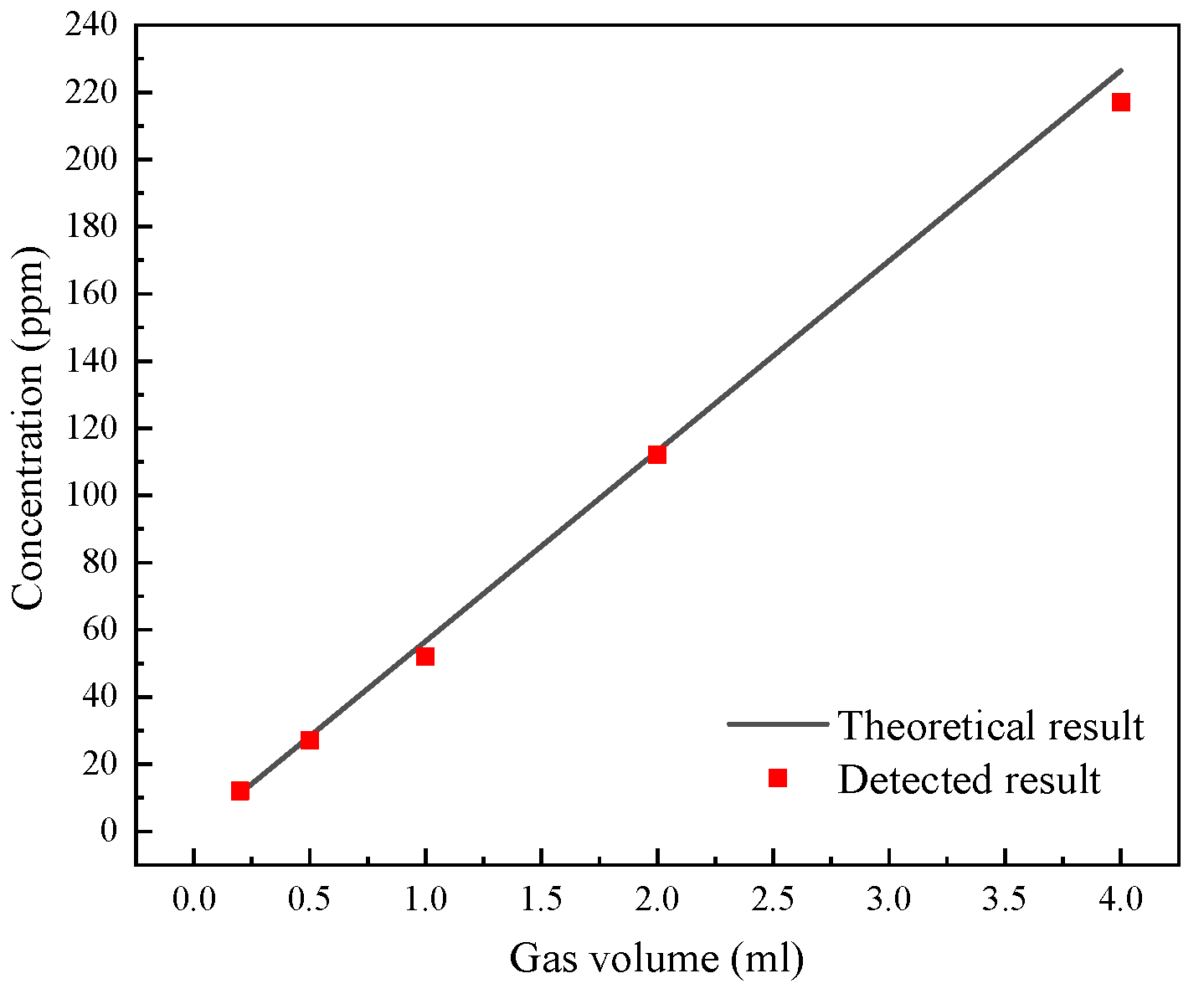
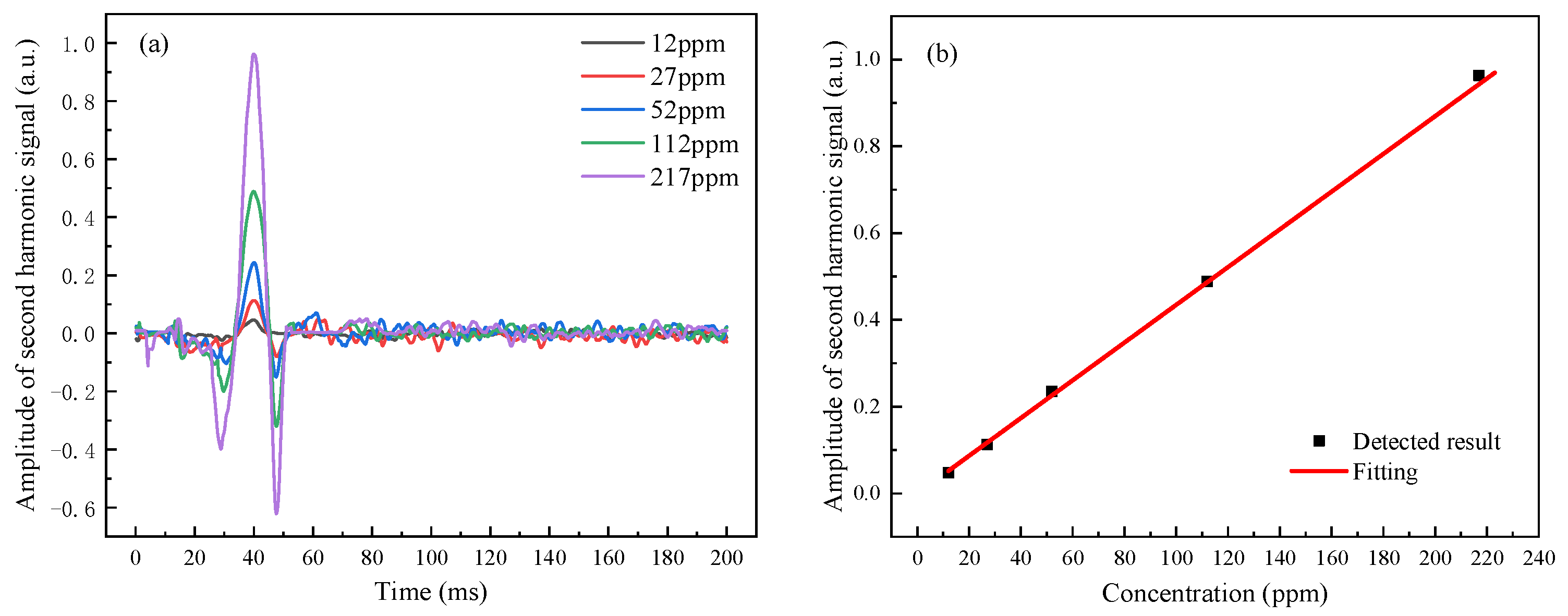
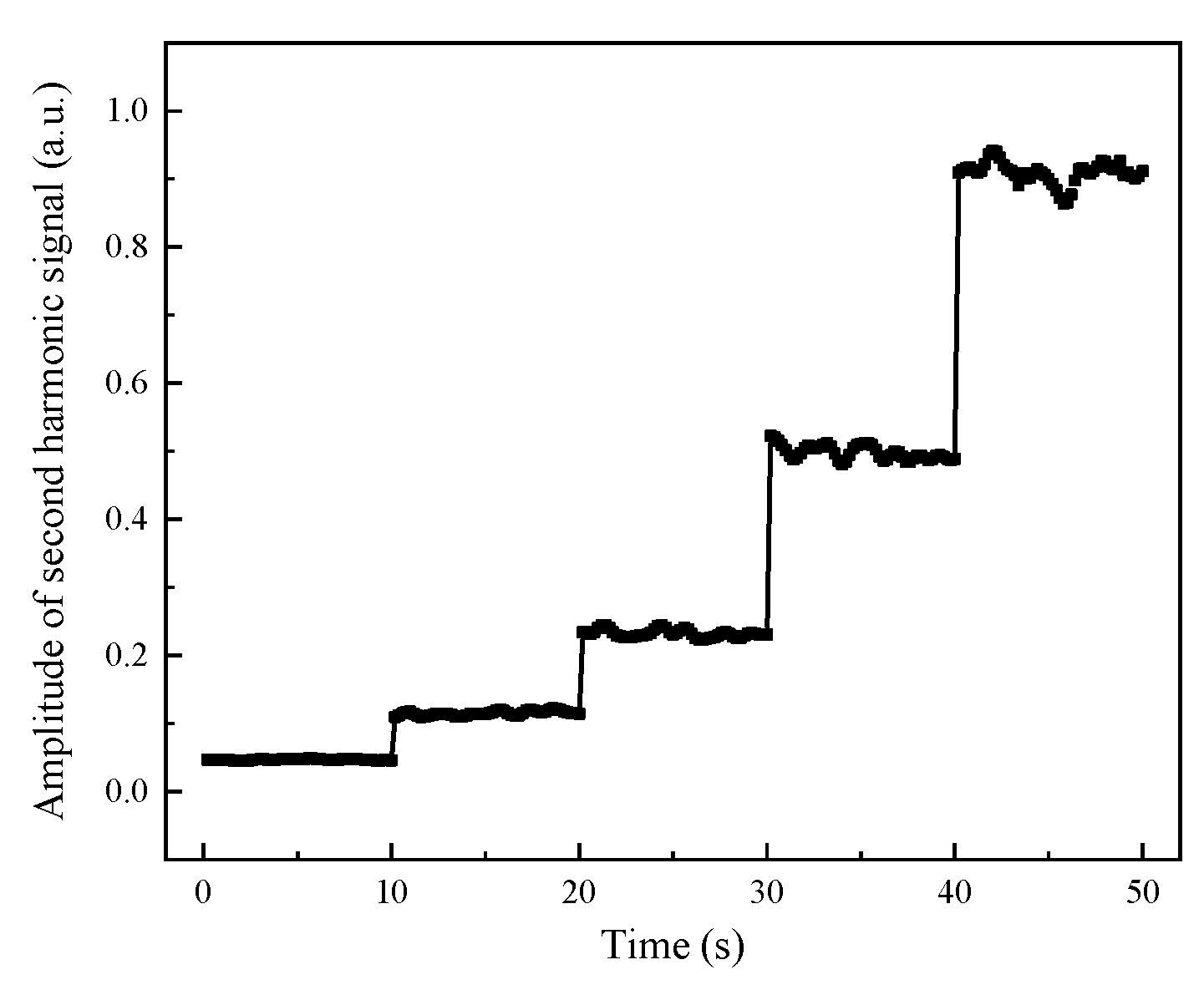
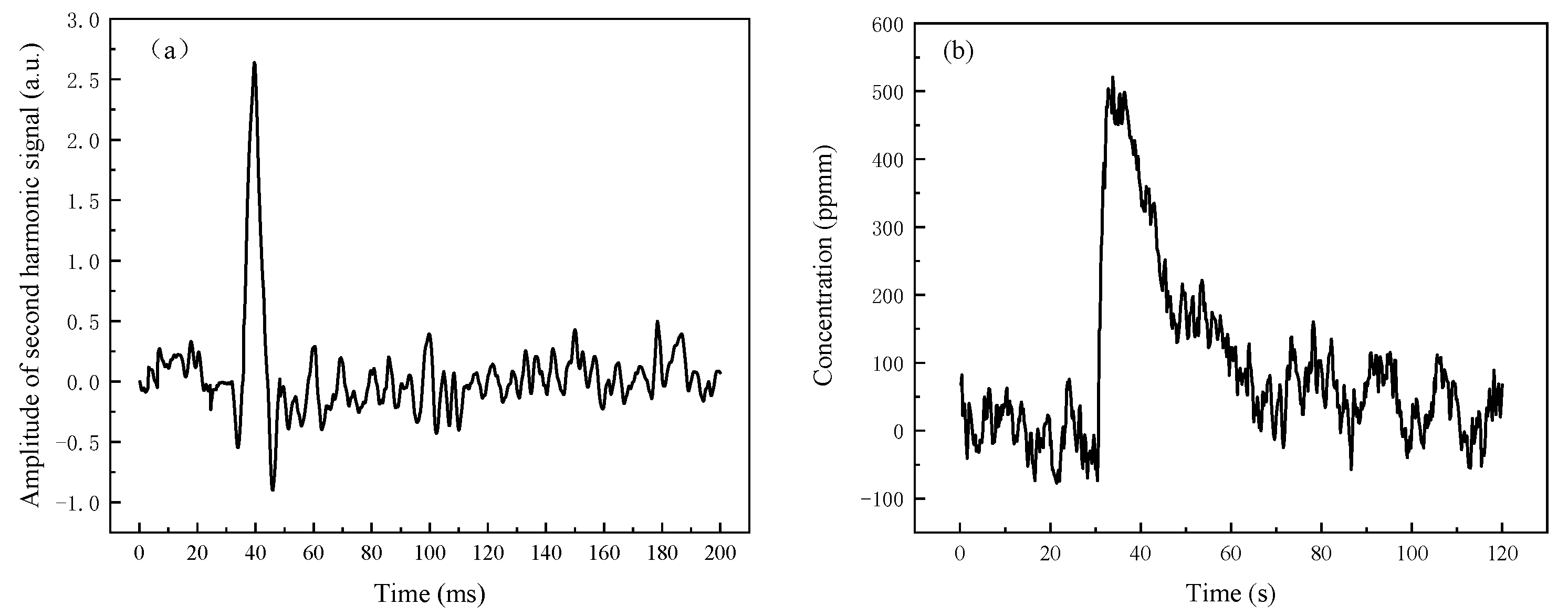
Publisher’s Note: MDPI stays neutral with regard to jurisdictional claims in published maps and institutional affiliations. |
© 2022 by the authors. Licensee MDPI, Basel, Switzerland. This article is an open access article distributed under the terms and conditions of the Creative Commons Attribution (CC BY) license (https://creativecommons.org/licenses/by/4.0/).
Share and Cite
Li, K.; Wang, B.; Yuan, M.; Yang, Z.; Yu, C.; Zheng, W. CO Detection System Based on TDLAS Using a 4.625 μm Interband Cascaded Laser. Int. J. Environ. Res. Public Health 2022, 19, 12828. https://doi.org/10.3390/ijerph191912828
Li K, Wang B, Yuan M, Yang Z, Yu C, Zheng W. CO Detection System Based on TDLAS Using a 4.625 μm Interband Cascaded Laser. International Journal of Environmental Research and Public Health. 2022; 19(19):12828. https://doi.org/10.3390/ijerph191912828
Chicago/Turabian StyleLi, Kun, Boyang Wang, Mingyao Yuan, Zhixiong Yang, Chunchao Yu, and Weijian Zheng. 2022. "CO Detection System Based on TDLAS Using a 4.625 μm Interband Cascaded Laser" International Journal of Environmental Research and Public Health 19, no. 19: 12828. https://doi.org/10.3390/ijerph191912828




